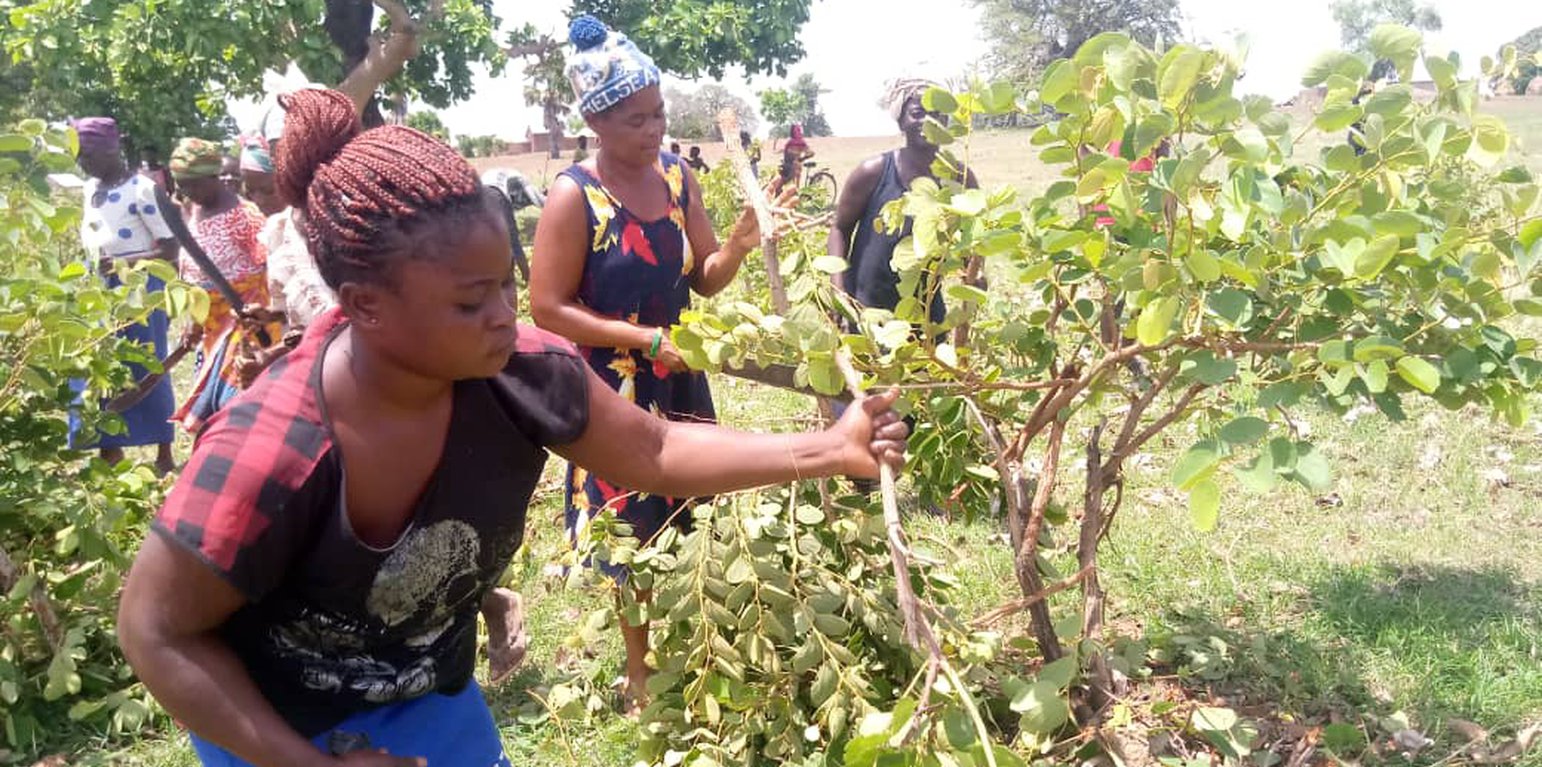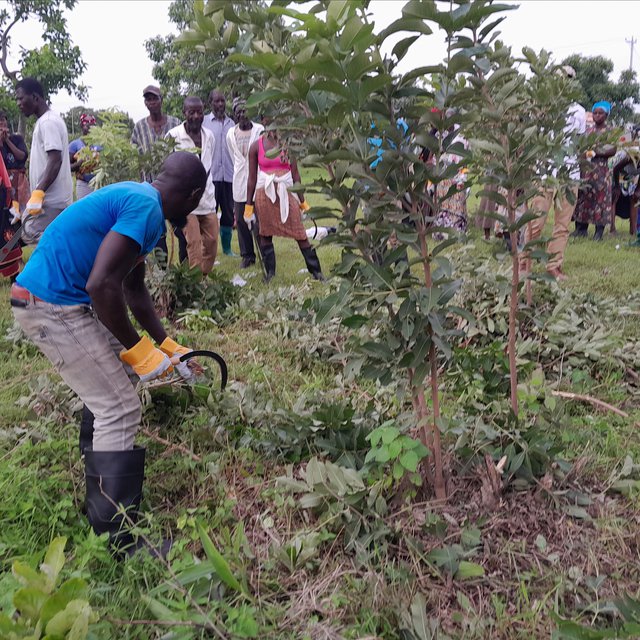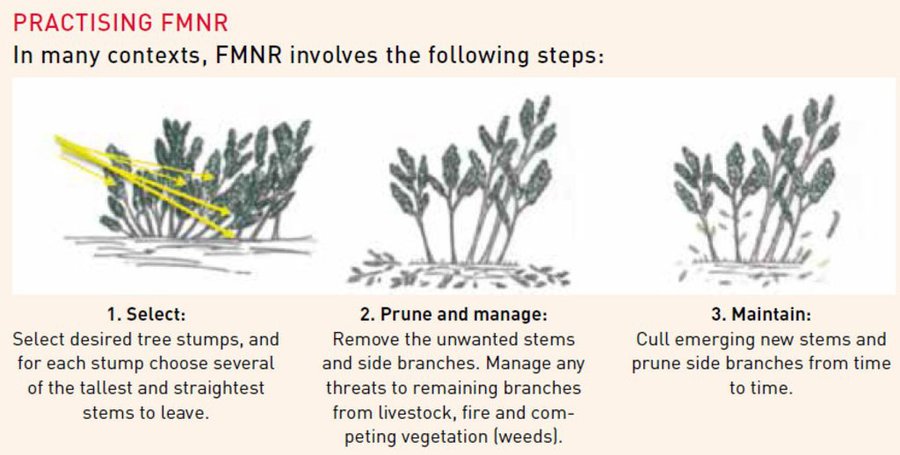



Farmer managed natural regeneration (FMNR) is an agroforestry practice that involves the deliberate protection and management of naturally regenerating woody vegetation by farmers on agricultural land. On farmland, selected trees are trimmed and pruned to manage their growth while promoting optimal growing conditions for annual crops (such as access to water and sunlight). Naturally it is a prerequisite that there should be evidence of sprouts from stumps or roots. FMNR is practiced through - but not limited to - the following:
1. Survey of the farm noting how many and what species of trees are present; In our project impact communities, the commonest indigenous tree species are Vitellaria paradoxa, Parkia biglobosa, Adansonia digitata, Piliostigma thonningii, Combretum spp, Diospyros mespiliformis, Lanea macrocarpa, Faidherbia albida, Acacia spp etc
2. Select the stumps of the desired species for regeneration; and
3. Select the best five or so stems and cull unwanted ones.
FMNR can restore degraded farmlands, pastures and forests by increasing the quantity and quality of woody vegetation, by increasing biodiversity and by improving soil structure and fertility through leaf litter and nutrient cycling. It has been reported in Senegal and Ghana in 2011 and 2012 that households practicing FMNR were less vulnerable to extreme weather shocks such as drought and damaging rain and windstorm. Conventional approaches to reversing desertification, such as tree planting, rarely spread beyond the project boundary once external funding is withdrawn. By comparison, FMNR is cheap, rapid, locally led and implemented. It uses local skills and resources – the poorest farmers can learn by observation and teach their neighbors. This technique is popular with land users because it is a low-cost and rapid sustainable land restoration technique. A well-established FMNR is succeeded by Farmer Managed Agroforestry (FMA) where farmers are cultivating annual crops as well are conserving indigenous tree species on the arable lands. Farmers go step ahead to do enrichment planting of preferred trees species such as Mangifera indica, Anacardium occidentale, Luceaena leucocephala etc.

Байршил: Widnaba Community in Bawku West district, Upper East, Гана
Дүн шинжилгээнд хамрагдсан технологи нэвтрүүлсэн газрын тоо: 100-1000 байршилд
Технологийн тархалт: тодорхой газар хэрэгжсэн/ жижиг талбайд төвлөрсөн
Тусгай хамгаалалттай газар нутагт?: Үгүй
Хэрэгжилтийн огноо: 2017; <10 жилийн өмнө (саяхны)
Нутагшууллын төрөл


| Төрөл зүйл | Тоо хэмжээ |
| үхрийн аж ахуй - сүүний ба махны чиглэлийн (жишээ нь зебу) | тодорхойгүй |














| Зардлын нэр, төрөл | Хэмжих нэгж | Тоо хэмжээ | Нэгжийн үнэ (Cedis) | Зардал бүрийн нийт өртөг (Cedis) | Нийт дүнгээс газар ашиглагчийн төлсөн % |
| Хөдөлмөр эрхлэлт | |||||
| Cutlass | piece | 40.0 | 33.0 | 1320.0 | |
| Welligtoon boot | pair | 40.0 | 50.0 | 2000.0 | |
| Communal labour | person | 40.0 | 30.0 | 1200.0 | |
| Pruning knives | piece | 40.0 | 24.0 | 960.0 | |
| Тоног төхөөрөмж | |||||
| Hand gloves | pair | 40.0 | 16.0 | 640.0 | |
| Sickles | piece | 40.0 | 28.0 | 1120.0 | |
| N/A | |||||
| таримал материал | |||||
| Natural shrubs | |||||
| Бордоо ба биоцид | |||||
| N/A | |||||
| Барилгын материал | |||||
| N/A | |||||
| Технологи бий болгох нийт үнэ өртөг | 7'240.0 | ||||
| Технологи бий болгох нийт үнэ өртөг, ам.доллар | 519.02 | ||||
| Зардлын нэр, төрөл | Хэмжих нэгж | Тоо хэмжээ | Нэгжийн үнэ (Cedis) | Зардал бүрийн нийт өртөг (Cedis) | Нийт дүнгээс газар ашиглагчийн төлсөн % |
| Хөдөлмөр эрхлэлт | |||||
| N/A | |||||
| Communal | person | 40.0 | 30.0 | 1200.0 | |
| Тоног төхөөрөмж | |||||
| N/A | |||||
| Cutlasses | piece | 40.0 | 33.0 | 1320.0 | |
| Wellington boots | pair | 40.0 | 50.0 | 2000.0 | |
| Sickles | piece | 40.0 | 28.0 | 1120.0 | |
| Handgloves | pair | 40.0 | 16.0 | 640.0 | |
| таримал материал | |||||
| Pruning knives | piece | 40.0 | 24.0 | 960.0 | |
| Бордоо ба биоцид | |||||
| N/A | |||||
| Барилгын материал | |||||
| N/A | |||||
| Бусад | |||||
| N/A | |||||
| Технологийн арчилгаа/урсгал үйл ажиллагаанд шаардагдах нийт үнэ өртөг | 7'240.0 | ||||
| Технологи арчилах ба урсгал ажлын нийт үнэ өртөг, ам.доллар | 519.02 | ||||
ГТМ хэрэгжихээс өмнөх тоо хэмжээ: 200kg of grains per acre
ГТМ хэрэгжиснээс хойшхи тоо хэмжээ: 200-400 kg of grain per acre
FMNR together with appropriate land preparation and improved agronomic practices promoted by the project have resulted in increased soil productivity
ГТМ хэрэгжихээс өмнөх тоо хэмжээ: N/A
ГТМ хэрэгжиснээс хойшхи тоо хэмжээ: N/A
Interventions such as post-harvest loss management trainings facilitated by the project have resulted in increased quality of farm produce.
ГТМ хэрэгжихээс өмнөх тоо хэмжээ: Scarce
ГТМ хэрэгжиснээс хойшхи тоо хэмжээ: Available
Through enrichment planting of browse tree species such as Leucaena, Albizia, there's availability of fodder for animals
ГТМ хэрэгжихээс өмнөх тоо хэмжээ: Scarce
ГТМ хэрэгжиснээс хойшхи тоо хэмжээ: Available
There are Faidherbia, Lecaena, Albizia as protein and vitamin source for ruminants in the communities
ГТМ хэрэгжихээс өмнөх тоо хэмжээ: Few (about 1 ruminants)
ГТМ хэрэгжиснээс хойшхи тоо хэмжээ: 2-3 ruminants per household
The project supported vulnerable house households with at least two she- goats each to keep for their well -being
ГТМ хэрэгжихээс өмнөх тоо хэмжээ: N/A
ГТМ хэрэгжиснээс хойшхи тоо хэмжээ: N/A
Prunings serve as readily available firewood. Some bigger branches are also pruned for use. Introduction of fast-growing tree species such as Tectona grandis enables farmer easily harvest wood
FMNR on farms create micro-climate which helps in preventing total crop failure.
ГТМ хэрэгжихээс өмнөх тоо хэмжээ: 0.5 acre
ГТМ хэрэгжиснээс хойшхи тоо хэмжээ: 1 acre
The project supports vulnerable families with improved maize and cowpea seeds in the cropping seasons to farm at least an acre of land
ГТМ хэрэгжихээс өмнөх тоо хэмжээ: N/A
ГТМ хэрэгжиснээс хойшхи тоо хэмжээ: N/A
Through trainings on appropriate land preparations, good agronomic practices etc there has been improvement in land management techniques.
ГТМ хэрэгжихээс өмнөх тоо хэмжээ: N/A
ГТМ хэрэгжиснээс хойшхи тоо хэмжээ: N/A
With the introduction of energy efficient cooking stoves, less fuel wood is used to generate more long-lasting heat for cooking and other domestic uses
ГТМ хэрэгжихээс өмнөх тоо хэмжээ: N/A
ГТМ хэрэгжиснээс хойшхи тоо хэмжээ: N/A
Water bodies experience less siltation and also last longer before drying up than before the technology
ГТМ хэрэгжихээс өмнөх тоо хэмжээ: N/A
ГТМ хэрэгжиснээс хойшхи тоо хэмжээ: N/A
ГТМ хэрэгжихээс өмнөх тоо хэмжээ: N/A
ГТМ хэрэгжиснээс хойшхи тоо хэмжээ: N/A
There's availability of clean surface water for livestock for especially loner duration of the dry season
ГТМ хэрэгжихээс өмнөх тоо хэмжээ: N/A
ГТМ хэрэгжиснээс хойшхи тоо хэмжээ: N/A
Surface water bodies are less contaminated by debris from the environment dure to sequestration by trees
ГТМ хэрэгжихээс өмнөх тоо хэмжээ: N/A
ГТМ хэрэгжиснээс хойшхи тоо хэмжээ: N/A
There's availability of more surface water bodies for irrigation purposes
ГТМ хэрэгжихээс өмнөх тоо хэмжээ: N/A
ГТМ хэрэгжиснээс хойшхи тоо хэмжээ: N/A
There's less surface water contamination
ГТМ хэрэгжихээс өмнөх тоо хэмжээ: N/A
ГТМ хэрэгжиснээс хойшхи тоо хэмжээ: N/A
Little or no expenditure on soil fertility improvement fertilizers
ГТМ хэрэгжихээс өмнөх тоо хэмжээ: N/A
ГТМ хэрэгжиснээс хойшхи тоо хэмжээ: N/A
Less inputs with resultant increased yields result in increased farmers income
ГТМ хэрэгжихээс өмнөх тоо хэмжээ: 1
ГТМ хэрэгжиснээс хойшхи тоо хэмжээ: 2
Farmers can now rear livestock in addition to crops for diverse income sources
ГТМ хэрэгжихээс өмнөх тоо хэмжээ: N/A
ГТМ хэрэгжиснээс хойшхи тоо хэмжээ: N/A
There's some form of release on workload as less time and distance is made in collecting fuelwood.
Increased in productivity for the peasant farmers ensures food security and some sort of self-sufficiency as some of the produce could be sold to meet other family needs.
ГТМ хэрэгжихээс өмнөх тоо хэмжээ: N/A
ГТМ хэрэгжиснээс хойшхи тоо хэмжээ: N/A
Food availability, access and utilization leads to improved nutrition and ultimately improvement in health conditions for the farmers.
The technology facilitates community to put in place structures towards environmental governance
The technology is gradually creeping into the government environmental protection and farming policies.
ГТМ хэрэгжихээс өмнөх тоо хэмжээ: N/A
ГТМ хэрэгжиснээс хойшхи тоо хэмжээ: N/A
Formation of community committees to spearhead land restoration approaches have reduce conflicts in communities.
The disadvantage in the communities have been supported with seeds and livestock for their welfare
There's minimal runoff due to increase in tree population on the environment
There's less of acid rains due to carbon sequestration by trees in the atmosphere
Increased in soil organic Carbon (SOC) build up and leaf litter serves as mulch and retains soil moisture for longer period.
Increased in tree density, SOC protects soil from adversaries
ГТМ хэрэгжихээс өмнөх тоо хэмжээ: N/A
ГТМ хэрэгжиснээс хойшхи тоо хэмжээ: N/A
There less soil loss as soil erosion and other harmful environmental agents are checked
ГТМ хэрэгжихээс өмнөх тоо хэмжээ: N/A
ГТМ хэрэгжиснээс хойшхи тоо хэмжээ: N/A
SOC builds up the topsoil layer of the soil
ГТМ хэрэгжихээс өмнөх тоо хэмжээ: N/A
ГТМ хэрэгжиснээс хойшхи тоо хэмжээ: N/A
There's less soil sealing as a result of appropriate land preparation and good agronomic practices the technology promotes .
There's less soil sealing as a result of appropriate land preparation the technology promotes.
Improved
The technology promotes less use of NPK fertilizers thereby reducing soil salinity
ГТМ хэрэгжихээс өмнөх тоо хэмжээ: N/A
ГТМ хэрэгжиснээс хойшхи тоо хэмжээ: N/A
Leaf litter increases soil organic matter content in the soil
ГТМ хэрэгжихээс өмнөх тоо хэмжээ: N/A
ГТМ хэрэгжиснээс хойшхи тоо хэмжээ: N/A
There is sequestration of acid forming gases by trees thereby reducing acidity
There's reduction in invasive alien species as they are culled in FMNR technology